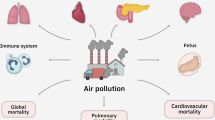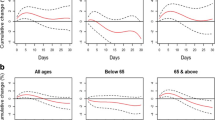Abstract
The influence of airborne pollution on mortality rates has been examined since the well known severe pollution episodes of Pennsylvania (1948) and London (1952). Three main epidemiological approaches are available: transversal studies, time series studies, prospective studies. The most frequently used method is the time series analysis, which retrospectively determines daily mortality rates as compared to daily pollution levels in a defined period. The vast majority of studies applying this approach confirm the existence of a positive correlation between mortality and airborne pollution. The relative risk of death during the most severely polluted days as compared to the least polluted days ranges between 1.02 and 1.13. Airborne pollution affects mortality as related to cardiovascular and chronic obstructive pulmonary diseases mainly in subjects previously affected by these pathologies. The dose–response mortality–pollution curve shows linear increments of mortality at low pollution levels, weak increments at high pollution levels. This phenomenon is attributed to the existence of subjects highly susceptible to pollution induced adverse health effects. These subjects, dying at low pollution levels, are not available to increase mortality rates at high pollution levels. Mortality is mainly related to the concentration of single pollutants, such as suspended particle matter, sulfur oxides, nitric oxides and ozone. Elderly are highly susceptible to pollution-induced mortality increases. Therefore, the study of mortality–pollution correlation is of particular interest in cities characterized by a relative prevalence of the elderly in the population. The latency period between pollution increases and related mortality increases falls in the 1–3 days interval range. The pollution–mortality relationship is influenced by many factors, such as the occurrence of exceedingly high or low environmental temperatures, influenza epidemics, etc. Many hypotheses has been raised to support the causality of the mortality–pollution association, including a direct effect of pollutants on cardiovascular and respiratory apparatus, and the release of inflammatory mediators affecting blood viscosity and pneumocytes homeostasis. On the whole, available data suggest that pollution is able to increase mortality only if associated to other risk factors determining an increased susceptibility in the exposed population.
Similar content being viewed by others
References
Firket M. The cause of the symptoms found in the Meuse Valley during the fog of December, 1930. Bull Acad Roy Med Belg 1931; 11: 683–741.
Schrenk HH. Epidemiology of the unusual smog episode of October, 1948: Preliminary report. In: Schrenk HH (ed.) Air Pollution in Donora, Pensylvenia. 1949; Bull. 306, Federal Security Agency, Public Health Services, Division of Industrial Hygiene.
Logan WPD. Mortality in London fog accident. Lancet 1953; 1: 336–338.
Bisanti L. Urban air pollution and mortality: A review. Epidemiol Prev 1995; 19: 13–21.
McMichael AJ, Anderson HR, Brunekreef B, Cohen AJ. Inappropriate use of daily mortality analyses to estimate longer-term mortality effects of air pollution. Int J Epidemiol 1998; 7: 450–453.
Dockerey W, Pope CA, Xu X, et al. An association between air pollution and mortality in six US cities. New Engl J Med 1993; 329: 1753–1759.
Katsouyanni K, Touloumi G, Spix C, et al. Short term effects of ambient sulphur dioxide and particulate matter on mortality in 12 European cities: Results from time series data from the APHEA project. Br Med J 1997; 314: 1658–1663.
Schwartz J. Air pollution and daily mortality in Birmingham, Alabama. Am J Epidemiol 1993; 137: 1136–1147.
Xu X, Gao J, Dockerey DV, Chen Y. Air pollution and daily mortality in residential area of Beijng, China. Arch Environ Health 1994; 49: 216–222.
Vigotti MA, Rossi G, Bisnati L, Zanobetti A, Schwartz J. Short term effects of urban air pollution on respiratory health in Milan, Italy, 1980–1989. J Epidemol Comm Health 1996; 50s: 71–75.
Saldiva PN, Pope CA, Schwartz J, et al. Air pollution and mortality in elderly people: A time-series study in Sao Paulo, Brazil. Arch Envrion Health 1995; 50: 159–163.
Borja-Aburto VH, Loomis DP, Bangdiwala S, Shy CM, Rascon-Pacheco RA. Ozone, suspended particulates and daily mortality in Mexico City. Am J Epidemiol 1997; 145: 258–268.
Katsouyanni K, Pantazopoulou A, Touloumi G, et al. Evidence for interaction between air pollution and high temperature in the causation of excess mortality. Arch Envrion Health 1993; 48: 235–252.
Makenbach JP, Looman CWN, Kunst AE. Air pollution, lagged effects of temperature and mortality: The Netherlands 1979–1987. J Epid Comm Health 1993; 47: 121–126.
Hemminki K, Pershagen G. Cancer risk of air pollution: Epidemiological evidence. Env Health Perspect 1994; 102s: 187–192.
Engholm G, Palmgren F, Lynge E. Lung cancer, smoking, and environment: A cohort study of the Danish population. Br Med J 1996; 312: 1259–1263.
Wu AH, Fontham ET, Reynolds P, et al. Previous lung diseases and risk of lung cancer among lifetime non-smoking women in the United States. Am J Epidemiol 1995; 141: 1023–1032.
Ceppi M, Vercelli M, Decarli A, Puntoni R. The mortality rate of the province of birth as a risk indicator for lung and stomach cancer mortality among Genoa residents born in other Italian provinces. Eur J Cancer 1995; 31A: 193–197.
Touloumi G, Pocock SJ, Katsouyanni K, Trichopoulos D. Short-term effect of air pollution on daily mortality in Athens: A time series analysis. Int J Epidemiol 1994; 23: 957–967.
De Flora S, Izzotti A, Walsh D, Degan P, Petrilli GL, Lewtas J. Molecular epidemiology of atherosclerosis. FASEB J 1997; 11: 1021–1031.
Schwartz J, Dockerey DW, Neas LM. Is daily mortality associated specifically with fine particles? J Air Waste Manag Assoc 1996; 46: 927–939.
Rahlenbeck S, Kahl H. Air pollution and mortality in East Berlin during the winter of 1981–1989. Int J Epidemiol 1996; 25: 1220–1226.
Izzotti A, Parodi S, Quaglia A, Garrone E, Casella C, Vercelli M. Impatto dell'inquinamento atmosferico da ozono sulla mortalità della popolazione esposta. In: Ugazio G (ed) Atti XV Convegno sulla Patologia da Tossici Ambientali, Sesto Fiorentino, Firenze (Italy), University of Turin, 1998; 147–163.
Derrienic F, Richardson S, Mollie A, Lellouch J. Short term effects of sulphur dioxide pollution on mortality in two French cities. Int J Epidemiol 1989; 18: 186–197.
Izzotti A, Balansky R, Coscia N, Scatolini L, De Flora S. Chemoprevention of smoke-related DNA adduct formation in rat lung and heart. Carcinogenesis 1992; 13: 2187–2190.
De Flora S, Izzotti A, Bartsch H, et al. DNA adducts and chronic degenerative diseases. Pathogenetic relevance and implications in preventive medicine. Mutat Res 1997; 366: 197–238.
Seaton A, MacNee W, Donaldson K, Godden D. Particulate air pollution and acute health effects. Lancet 1995; 345: 176–178.
Peters A, Doring A, Weichmann HE, Koenig W. Increased plasma viscosity during an air pollution episode: A link to mortality? Lancet 1997; 349: 1582–1587.
Author information
Authors and Affiliations
Rights and permissions
About this article
Cite this article
Izzotti, A., Parodi, S., Quaglia, A. et al. The relationship between urban airborne pollution and short-term mortality: Quantitative and qualitative aspects. Eur J Epidemiol 16, 1027–1034 (2000). https://doi.org/10.1023/A:1010844923176
Issue Date:
DOI: https://doi.org/10.1023/A:1010844923176




